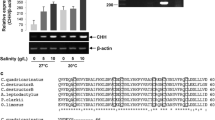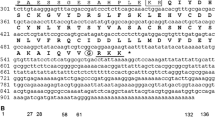Abstract
The hypercalcemic and hyperglycemic factors of the eye-stalk ofScylla serrata (Forskal) have been shown to be responsible for maintaining high concentrations of calcium and sugar in the blood during proecdysis. On eye-stalk ablation, the withdrawal of calcium appears to be affected and this leads to an unsuccessful moulting and death of the animal. The significance of this phenomenon in relation to relevant evidences on the moulting process of crustaceans has been discussed.
Similar content being viewed by others
References
Abramowitz, A. A., Hisaw, F. L. and Papandrea, D. N. “The occurrence of a diabetogenic factor in the eye-stalks of Crustacea,”Biol. Bull., Woods Hole, 1944,86, 1–5.
Allport, N. L. and Keyser, J. W.Colorimetric Analysis, Chapman and Hall Ltd., London, 1957.
Carlisle, D. B... “On the hormonal control of water balance inCarcinus,”Pubbl. Staz. Zool., Napoli, 1955,27, 227–31.
—————.. “On the hormonal inhibition of moulting in decapod crustacea. The terminal anecdysis in crabs,”J. mar. biol. Ass., U.K., 1957,36, 291–307.
—— and Knowles, F. G. W.Endocrine Control in Crustacea, Cambridge Monograph in Experimental Biology, 10, University Press, Cambridge, 1959.
*Cole, W. H... “The composition of fluids and sera of some marine animals and of the sea-water in which they live,”J. Gen. Physiol., 1940,23, 575–84.
Guyselman, J. B... “An analysis of the moulting process in the fiddler crab.Uca pugilator,”Biol. Bull., Woods Hole, 1953,104, 115–37.
Havel, V. J. and Kleinholz, L. M. “Effects of seasonal variation, sinus gland removal and the eye-stalk removal on concentrations of blood calcium inAstacus,”Anat. Rec., 1951,111, 571–72.
Hawk, P. B., Oser, B. L. and Summerson, W. H...Practical Physiological Chemistry, McGraw-Hill Book Co., Inc., New York, 1954.
Kleinholz, L. H. and Little, B. C. “Blood sugar values in the marine crustaceanLibinia emarginata,”Anat. Rec., 1948,101, 734.
—————.. “Studies in the regulation of blood sugar concentration in Crustaceans. 1. Normal values and experimental hyperglycemia inLibinia emaginata,”Biol. Bull., Woods Hole, 1949,96, 218–27.
——, Havel, V. J. and Reichart, R. “Studies in the regulation of blood sugar concentration in Crustaceans. II. Experimental hyperglycemia and the regulatory mechanisms,” Ibid., 1950,99, 454–68.
*Kincaid, F. D. and Scheer, B. T. “Hormonal control of metabolism in Crustaceans. IV. Relations of tissue composition ofHemigrapsus nudus to intermoult cycle and sinus gland,”Physiol. Zool., 1952,25, 372–80.
Knowles, F. G. W. and Carlisle, D. B. “Endocrine control in Crustacea,”Biol. Revs., Cambridge Phil. Soc., 1956,31, 396–473.
Kyer, D. L... “The influence of the sinus glands on gastrolith formation in the cray fish,”Biol. Bull., 1942,82, 68–78.
Menon, K. R. .. “Mechanism of salinity tolerance in an estuarine crab,Scylla serrata (Forskal),” (1968, In press).
—— and Sivadas, P... “Blood sugar regulation in the crabScylla serrata. I. Effect of injection of eye-stalk extract,”Indian J. exptl. Biol., 1967,5, 176–78.
*Parry, G... “Ionic regulation on the Palaemonid prawnPalaemon serratus,”J. Exptl. Biol., 1954,31, 601–13.
Passano, L. M... “Moulting and its control,” inPhysiology of Crustacea, 1960,1, 473–536, Edited by Waterman, T. H., Academic Press, N.Y.
Prosser, G. L. .. “Inorganic ions,” inComparative Animal Physiology, 1952, pp. 75–102, Edited by Professor C. L. Saunders, Philadelphia, U.S.A.
——, Green, J. and Chow, T. J. “Ionic and osmotic concentrations in blood and urine ofPachygrapsus crassipes acclimatized to different salinities,”Biol. Bull., 1955,109, 99–107.
Rangnekar, P. V., Sabnis, P. B. and Nirmal, H. B. “The occurrence of a hypoglycemic factor in the eye-stalks of freshwater crab,Paratelphusa jacquemontii,”J. Anim. Morph. Physiol., 1961,8 (2), 137–44.
Scheer, B. T. and Scheer, M. A. R. “The hormonal regulation of metabolism in Crustaceans. I. Blood sugar in spiny lobsters,”Physiol. Comp., 1951,2, 198–209.
*Scudamore, H. H... “The influence of the sinus gland upon moulting and associated changes in the cray fish,”Physiol. Zool., 1947,20, 187–208.
Author information
Authors and Affiliations
Additional information
Communicated by Dr. N. K. Panikkar,f.a.sc.
Rights and permissions
About this article
Cite this article
Menon, K.R., Sivadas, P. The hormonal control of blood calcium and sugar levels in the estuarine crabScylla serrata (Forskal). Proc. Indian Acad. Sci. 67, 132–140 (1968). https://doi.org/10.1007/BF03051694
Received:
Issue Date:
DOI: https://doi.org/10.1007/BF03051694




